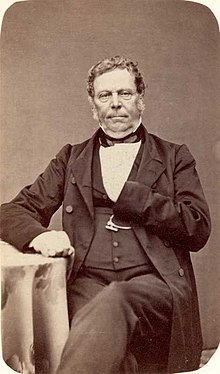Frognerseteren
Frognerseteren , also known as Frognersætra , is a recreational area and forest in Nordmarka within the city of Oslo, and a popular hiking and excursion destination in Norway . Nearby lies Øvresetertjern Lake. The eponymous restaurant Frognerseteren with an attached hotel is located on the southern slopes of Tryvannshøgda near Holmenkollen , on Holmenkollveien. The Holmenkollveien leads from Sørkedalsveien in Oslo's Vestre Aker district to Frognerseteren. The Frognerseteren stasjon is the terminus of the Holmenkollbanen . The area was originally an alpine pasture , which until 1848 belonged to Frogner Manor ( Frogner Hovedgård ) and the former municipality of Aker . Part of the Nordmarka Forest was formerly known as the Trevollskogen and Frognerseterskogen forests . In 1891 the Frognerseteren restaurant was opened. Frognerseteren and Frognerseterskogen were sold to the Christiania municipality in 1889 and were the first city-owned forest in today's capital Oslo.
history

Frognerseteren and Frognerseterskogen (Frognerseteren forest) originally belonged to the Frogner estate (Norwegian Frogner Hovedgård , Frognerseteren is derived from the same name). The owners of the Frogner estate, the forest and the sawmill on Frognerbekken (Frogner River), owned several properties and land in Nordmarka, and they were successful in the wood business. The entrepreneur and landowner Benjamin Wegner sold the manor house on Feldweg in 1848, but kept Frognerseteren and the woods. Wegner's heirs sold Frognerseteren to the banker, entrepreneur and nature sports enthusiast Thomas Johannes Heftye in 1864 .
Thomas Heftye had the Heftye villas ( Heftye villas ) designed by the architect Herman Major Schirmer in 1867 . These buildings were the first huts in Oslo and forerunners and models for other similar buildings in Norwegian forests and mountains later. Heftye also paved new paths in the area so that townspeople could better reach Frognerseteren and Nordmarka. In addition to the "villa", he built a small open-air museum and other buildings.
Heftyes heirs again sold Frognerseteren in 1899 to the municipality of Kristiania (Oslo). The municipality had already advocated the expanded use of forests in Nordmarka in the previous year, with the aim of making the area more attractive for day-trippers and sports enthusiasts. The company Selskabet for Anlæggene paa Holmen- og Voxenkollen was founded for this purpose . The acquisition of Frognerseteren was a further step and the first forest land of today's Oslo.
Frognerseteren restaurant
The first buildings were in 1891 the main restaurant Hovedrestauranten and 1896, the sports halls in dragon style to designs and plans by architect Holm Munthe , who also projected other buildings in this style in the capital, built. The restaurant is a wooden house in the rustic national romantic style and is equipped with chimneys in several rooms. The restaurant's menu is based on traditional Norwegian cuisine. The restaurant was rebuilt and expanded in 1909.
Holmenkoll race
For many years, Frognerseteren was the starting point for the 50 km cross-country skiing competition Holmenkollrennen ( Holmenkollrennene ) organized by the Norwegian Ski Association ( Ski-Idrettens Fremme ).
Holmenkollbanen
Frognerseteren is a popular starting point for hikes and excursions to Nordmarka in summer and winter to the Holmenkollbane (Holmenkoll Railway), which opened in 1898.
literature
- Gry Larsson: Appreciate Frognerseteren. (PDF; 1.8 MB). In Byminner . No. 3-2011, pp. 28-35.
Web links
- Frognerseteren in the store norske leksikon
- Frognerseteren Restaurant on frognerseteren.no
- Husmanncontrakt for husmannsplass på Frognerseteren inngått med husmannen Ole Knudsen i 1837 , Oslo Museum
Individual evidence
- ↑ a b Andreas Vevstad: Det begynte med Frognerseterskogen: Oslo communes skoger 1889–1989 . Aschehoug, 1989.
Coordinates: 59 ° 58 ′ 40.8 " N , 10 ° 40 ′ 38.3" E


